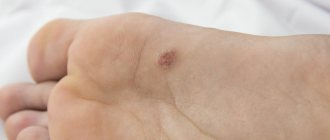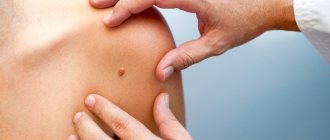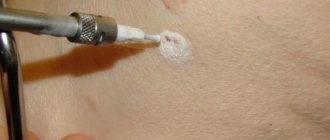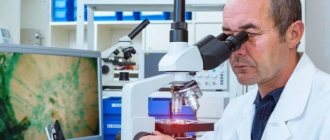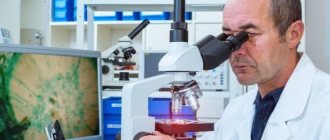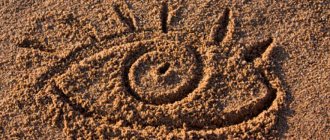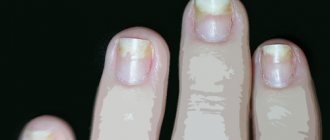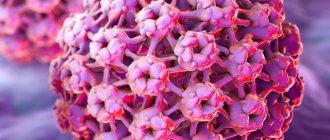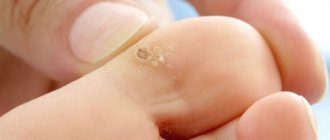Warts are a fairly common problem for many people. They arise due to the entry of the human papillomavirus into the body and are small-sized neoplasms with a keratinized crust or completely soft growths.
Most often, warts are not painful, but there are reasons why warts can cause discomfort and pain.
Types and reasons
Warts are:
There are a lot of varieties of warts; they are classified according to a number of characteristics:
- Simple. They occur on exposed parts of the body, arms, legs, face, and scalp. They are usually not dangerous, but they are not aesthetically pleasing and can multiply quickly, affecting large areas of the skin. They are arranged as if in “families”.
- Plantar. Their localization is exclusively on the feet. Causes discomfort when walking.
The main cause is infection with the human papillomavirus, which affects the mucous membranes and skin.
Symptoms that may accompany wart pain
Painful growth is generally not the only symptom of negative changes that a patient may complain about at an appointment with a dermatovenerologist.
Often an additional group of complaints is presented regarding the affected area of the skin.
These include:
- Inflammatory symptoms
Symptoms of inflammation most often include pain.
However, they are not limited to pain.
The patient may complain that the tumor has become red and very sensitive to touch.
In some cases, it may be noted that it has increased in size or the tissue around it has become swollen.
- Skin symptoms
Patients often feel that the wart is itchy and a pronounced burning sensation appears in the area.
These symptoms contribute to increased inflammation.
Especially if a person cannot restrain himself and combs the problem area.
- Blood discharge
Often, if the scratching is very strong, blood is released from the formation in small quantities.
If the growth is very severely injured, the bleeding may be noticeable, and sometimes medical assistance is required to stop it.
Human papillomavirus
This is one of the most common viruses on Earth. Infection can occur in several ways:
- contact and household (through touch);
- sexual (genital, anal, oral-genital);
- in childbirth from mother to child.
The period of development of the disease ranges from several weeks to tens of years, this is explained by the fact that the virus may not manifest itself for a long time, but as soon as the immunity becomes a little weaker, growths immediately appear on the skin and/or mucous membranes. The main danger of this disease is that certain types of HPV are highly likely to cause the formation of a malignant tumor (cancer of the skin or mucous membranes). To make sure that the disease will not lead to the formation of a tumor, it is necessary to undergo examination by a doctor and not self-medicate.
A wart hurts, what should I do?
Patients often ask doctors about what to do if a wart hurts.
Any competent dermatovenerologist will tell you that if pain occurs, you should immediately consult a doctor.
At the appointment, the doctor will be able to decide what the cause of the pain is, and also choose the best option to eliminate it.
Moreover, in some cases the growth will have to be removed, in some cases the clothing habits will have to be changed.
And in some cases you simply use light ointments to care for the defect (for example, Fenistil to eliminate itching, etc.).
The decision on tactics is made in each individual case individually.
If a wart hurts after celandine or other removal products, it is important to properly care for the injured skin.
First of all, the patient is recommended to treat the affected area with iodine or another antiseptic substance.
You can also apply a bandage or adhesive tape to the wound.
This will prevent pathogenic microorganisms from entering it.
If the pain cannot be relieved for a long time, it is worth visiting a doctor for consultation and deciding what to do next.
Symptoms and types of warts on the foot
A plantar wart appears as a callus-like thickening with a stratum corneum layer of skin. It interferes with walking and causes pain. The passive state is characterized by slow reproduction, not reaching the stratum corneum of the epithelium, so this condition does not manifest itself externally.
The active state is characterized by the fact that the virus develops rapidly and, rising to the upper layers of the epidermis, manifests itself in numerous symptoms. The plantar wart is also called the spinous wart, chicken wart. The virus enters during its contact with the skin through cuts and abrasions in the outer layer of the skin:
- First, a small yellowish-gray papule with an uneven surface appears.
- Gradually, the small element becomes dense and acquires a dirty color.
From the inside, a plantar wart looks like fused papillae of different sizes with a pinkish tint. Additional capillary vessels form there, causing bleeding if you catch a wart.
Pathogenesis of genital warts
HPV is found in the cellular structures of the skin and mucous membranes, so it can be transmitted from men to women, from adults to children. The long latent period of infection makes early diagnosis of the disease difficult. Condylomas are not immediately visible to the naked eye. To activate HPV, a large number of these pathogens is necessary, only then the papillomavirus “comes out”, represented by genital warts. An increase in HPV may occur due to decreased immunity in women or men. Genital condylomas are caused by the process of atypical reproduction of the human papilloma virus; under its influence, epithelial cells grow and develop with pathology. The skin and mucous tissues change and this is how condylomas appear. Growths in the form of warts and papillae can be single or massive, turning into entire “conglomerates” of condylomas.
Removal of plantar warts
It is worth treating a plantar wart if:
- There are painful sensations.
- The wart is bleeding.
- There were spots on it.
- The wart quickly increases in size.
There are many treatment methods. One of them is cryodestruction. The meaning of the method is that the wart is exposed to liquid nitrogen at a temperature of minus 196 degrees. The virus-affected area is frozen and the wart is removed.
The usual and aggressive method of exposure is used. With the aggressive method, nitrogen is applied for a few seconds longer, but this method is more painful. It is important to note that if a wart appears and exists for more than six months, then the effectiveness of cryodestruction is greatly reduced, and the meaning of such an operation, accordingly, also disappears.
After removing a plantar wart using liquid nitrogen, you should follow some recommendations:
- the blister remaining at the site of the wart cannot be opened;
- to avoid mechanical damage, use a sterile bandage rather than a plaster;
- Treat the affected area with salicylic alcohol 2% twice a day;
- try to prevent water from entering the affected area.
Another method is laser coagulation. This is one of the most common methods for removing warts. Most laser systems are equipped with a special cooling system. Thus, the procedure takes place with minimal discomfort and does not allow inflammation, since the laser has antiseptic properties. Moreover, this is a non-contact method.
There are several ways:
- Carbon dioxide (CO2) laser. Treatment in this case occurs using infrared light. The method is 70% effective, but the downside is that healthy tissue can also be damaged.
- Erbium laser. This treatment method uses a shorter wavelength, which reduces the likelihood of scarring after surgery. Efficiency is typically 75%.
- Pulsed dye laser. With this method of exposure, the primary destruction of dilated capillaries in the wart and stimulation of the immune system, which contributes to effective healing. The effectiveness of treatment is about 95%.
After laser treatment, a crust forms on the affected area, which disappears on its own within seven to ten days. The recommendations for this method of treatment are the same as after exposure to nitrogen - avoid mechanical damage and ingress of water.
The next way to remove warts is electrocoagulation. In this case, a high frequency current is applied to the wart. Treatment is carried out under local anesthesia. Exposure of a wart to high temperatures leads to the evaporation of cells affected by the papilloma virus. Another advantage of this method is that cauterization of blood vessels prevents bleeding. After surgery, a crust forms on the affected area of the skin, which disappears within 7 to 10 days.
A plantar wart can be treated with direct surgery. In this case, excision occurs under local anesthesia, then sutures are applied. After the operation, the doctor will prescribe certain recommendations. Thus, it is recommended to prevent water and soap from entering the affected area, not to tear off the resulting crust, and to treat the affected area with an antiseptic in the first 7-10 days.
For each type of operation there are certain contraindications. Thus, it will be impossible to perform the operation if the following occurs:
- pregnancy;
- diabetes;
- malignant tumors in the body;
- infection and inflammation around the wart;
- exacerbation of herpes;
- elevated temperature.
If your blood pressure is high, the procedure should also be postponed.
Pain when a wart is damaged
If the wart is inflamed and hurts, then first of all you should think about the fact that it has been damaged.
This happens most often if the formation is localized in some unfortunate place.
For example, this could be the armpit, the area under the breasts of the fair sex, etc.
The growth may be located in a seemingly problem-free place.
But at the same time, when wearing clothes, it can be influenced by friction that occurs upon contact with fabrics.
Damage to the formation is the most common cause of unpleasant symptoms.
Traumatization can be either quite pronounced, up to the appearance of blood, or weak, but systematic.
The second option is most often found during friction.
Doctors draw the attention of patients to the fact that problem areas should remove growths as early as possible.
This will help avoid their irritation and subsequent negative changes.
Also, all pathogenic growths, which are often rubbed with clothing, must be removed as early as possible.
Provided that a person does not have the opportunity to change style.
An option may be to change synthetic clothing to natural ones.
There is no guarantee that this approach will be an effective way to solve the problem.
How to treat a lump on your thumb that hurts
Unfortunately, this problem is usually caused by chronic diseases and cannot be completely cured. Only hygroma can be removed once and for all. All other types of growths will remain for life - but exacerbations can be avoided if stable remission is achieved.
Rheumatoid arthritis is treated with corticosteroids or non-steroidal anti-inflammatory drugs. These same non-steroidal anti-inflammatory drugs, as well as colchicine, are effective against gout.
For osteoarthritis, chondroprotectors, finger therapeutic exercises and physiotherapy sessions are prescribed: multi-channel electrical stimulation and laser therapy. With multichannel electrical stimulation, muscles are stimulated with short pulses of electricity to relieve tension and improve blood flow. During the laser therapy procedure, a laser beam is applied to the joint growth to relieve inflammation and activate blood flow within the tissues.
Osteoarthritis is also treated with physiotherapy: ultrasound (reduces tissue volume), shock wave therapy (activates blood flow, eliminates swelling and pain by exposure to acoustic impulses), laser therapy.
Surgery may be required if the cartilage and surfaces of the joints are severely damaged in the later stages of arthritis or arthrosis, and the fingers become swollen, stiff and painful. In especially severe cases, endoprosthetics is prescribed, when a worn-out joint is replaced with an artificial one. The operation can be performed in the presence of a malignant tumor. The oncologist prepares an individual therapy program for each patient.
Traditional medicine is powerless when there is a lump and pain on the finger joint. Not a single homeopathic remedy contains components that would dissolve the lump. Therefore, relying on chance in the case of such a disease is extremely undesirable: all hopes for a miracle can ultimately lead to serious consequences.
Forget about potatoes and threads, consult a doctor
This trick will not work for a person with a strong nervous system. Therefore, leaving aside funny stories with dead cats and medicine from the tap, I must say: if you find some excess on your skin, do not rush to your dear folk medicine. Self-medication can be fraught with complications. For example, when you remove warts on your own, severe inflammation often occurs, which provokes the spread of this virus around, and after a week you may see 21 warts instead of one. In another case, bluish-red dense keloid scars may form. So it’s still not worth taking risks with this - it’s better to consult a dermatologist (appointment schedule). In addition, in appearance, warts can resemble completely different, much more serious neoplasms. The doctor, having determined that you have a harmless wart, will choose the appropriate way to remove it.
Diagnosis of inflammation
It is not difficult to recognize inflammation, but determining the nature and cause of the disease is possible only after examination and a complete examination. For this purpose, experts prescribe a dermatoscope, which helps to examine the wart in great detail and identify all the features of its appearance.
At the same time, cytological analysis is popular in the field of diagnostics, allowing one to study the cellular structure of papilloma and determine the presence of benign and malignant formations.
After receiving all the results of the study, doctors can make an accurate diagnosis and select the most effective treatment, depending on the individual characteristics of the human body.
Causes of warts
A question that worries even those who have not encountered this: why do warts appear? The main method of infection is contact. If you come into contact with a person who already has HPV in their body, there is a high probability that it will be transmitted to you, especially if there are associated factors. The main method of transmission is through handshakes. You can also become infected through common household items, such as bed linen, towels, slippers, etc. There is a high risk of catching the virus in public places - in swimming pools, baths, gyms, etc.
The risk of contracting warts increases under the influence of various unfavorable factors
:
- There are small injured areas on the arms and legs. People who do physical labor at work are at risk. It is extremely difficult for such employees to keep their hands from injury while performing work tasks. Cracks, scratches, and cuts appear on the hands, through which HPV can easily penetrate.
- Decreased protective immune functions of the body. You can determine the problem yourself. Just keep track of how often you get colds throughout the year. An indicator of 4 times or more should cause concern.
- Violent sweating in the hands and feet.
These factors make it easier for the papilloma virus to enter the patient’s body and cause the appearance of warts. The infection is characterized by a long incubation period - the first rash in some cases appears only 1.5 months after infection.
Clinical picture of warts
Externally, warts are dense nodules with a diameter of 1 to 10 mm (sometimes more), round or polycyclic in shape. Their surface is covered with cracks, horny layers, and vegetations. The color of warts often does not differ from the healthy skin surrounding them, but under a magnifying glass you can see black-brown dots, which are capillaries filled with blood clots.
The rash can be represented by either one element or multiple, randomly located isolated nodules. After a wart is removed, new ones (daughter ones) may appear around it, arranged in a circle. Warts are localized in easily injured areas: hands, fingers, knees. Localization of warts on the fingers and palms leads to changes in the skin pattern. In this situation, the recovery of fingerprints is a sign of recovery.
There are several types of warts.
Common warts
Dense, dry, limited, painless keratinized elevations with an uneven villous surface, the size of a pinhead to a pea. They can merge to form large plaques. Most often located on the hands.
Plantar warts
They are a type of common warts - they appear in places where shoe pressure is applied, especially in those who sweat a lot. Very dense, keratinized, gray-dirty plantar warts are characterized by severe pain that prevents walking; sometimes cause temporary disability.
Flat or juvenile warts
They usually occur in children and young people. They look like round or irregularly shaped flat nodules that are located on the back of the hands, as well as on the skin of the face. The appearance of flat warts is promoted by skin irritation (they often occur along the course of scratches, cuts, etc.).
Beware of abrasions and cuts
You can “catch” the virus from a sick person through direct contact, for example, by shaking hands. Or through infected objects: toys, handrails in public transport. Two to three hours of virus life in the external environment is enough for someone to become infected: the infection is quite common. Factors predisposing to infection are sweating (which, by the way, also depends on the state of the nervous system) and microtraumas on the skin. Microtraumas always exist; they are inevitable during household work: washing, cooking, cleaning, and in children they occur even during such innocent activities as modeling from plasticine.
Preventing HPV infection
Condylomas must be prevented by preventive measures:
- use of contraceptives during sexual relations;
- increasing immunity;
- proper balanced nutrition;
- taking vitamins;
- compliance with hygiene standards;
- fight against bad habits;
- increasing stress resistance.
Regular visits to the doctor are a good preventative measure. The use of antiviral ointments, as well as vaccination against HPV, is prevention that will make people’s lives full.
Pregnancy and condylomas
Condylomas are an alarming signal for pregnant women. HPV in the body of the expectant mother does not have a harmful effect on the fetus, but such a lady must be under the supervision of the attending physician at all times. You can resort to removing growths only at the 28th week of pregnancy, not earlier. If the formations have settled on the genitals, then there is a high probability that the baby will acquire HPV while passing through the birth canal. If the infection is not treated, then the unpleasant moments associated with thrush increase in pregnant women. The best option is a thorough examination before pregnancy for HPV and, if it is detected, mandatory and complete treatment.
Symptoms
The types of warts also affect the symptoms experienced by an infected patient. Moreover, all types of formations are characterized by a list of identical symptoms:
- The appearance of single or multiple neoplasms. Warts can appear not only on the skin. A rash on the mucous membranes is also possible.
- When pressing on the surface of the formation, painful sensations occur.
- The nail plate becomes deformed, and the periungual fold grows in the affected area.
- Deformation of the feet in case of massive lesions, severe pain.
